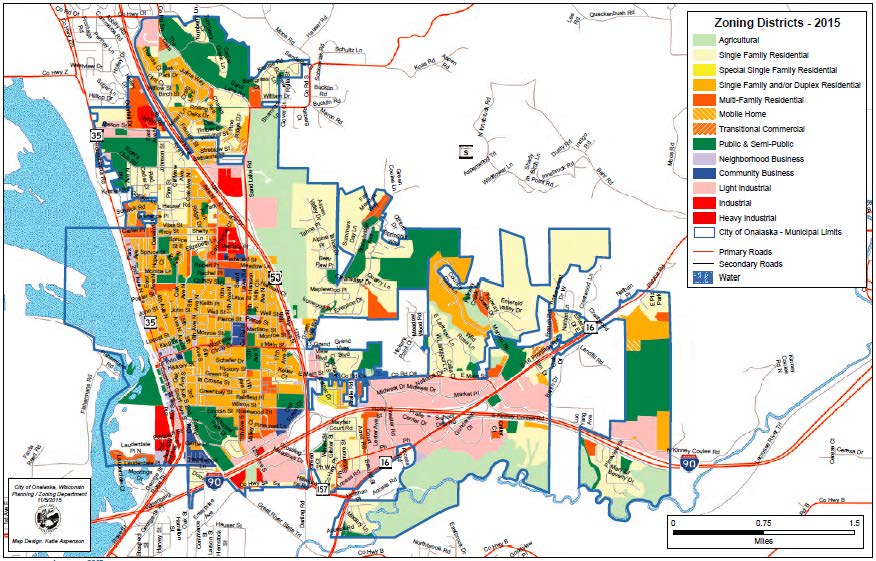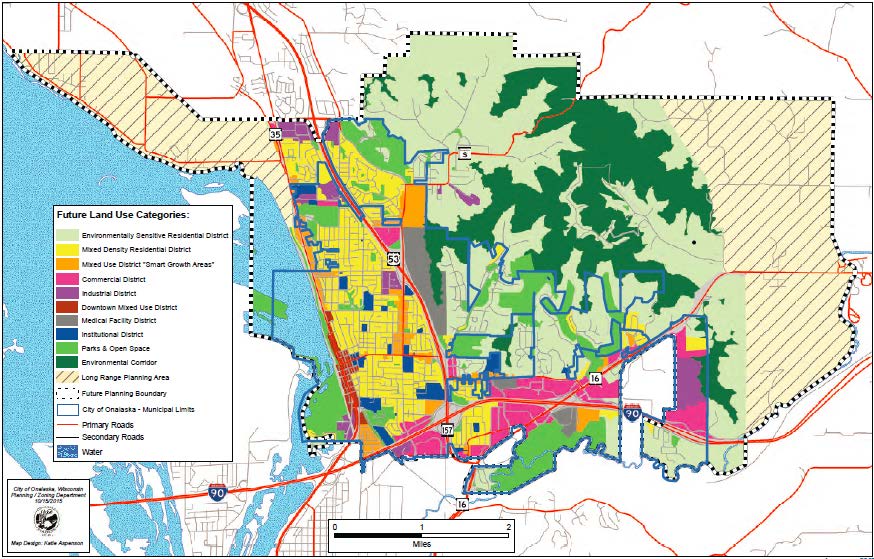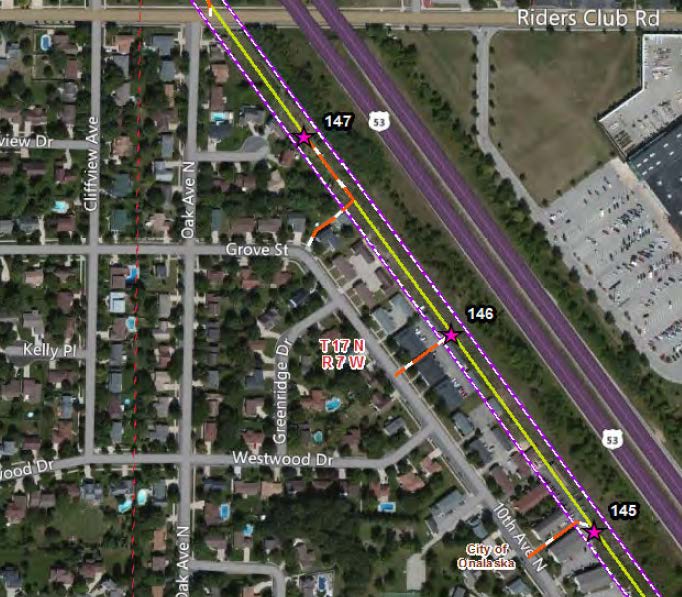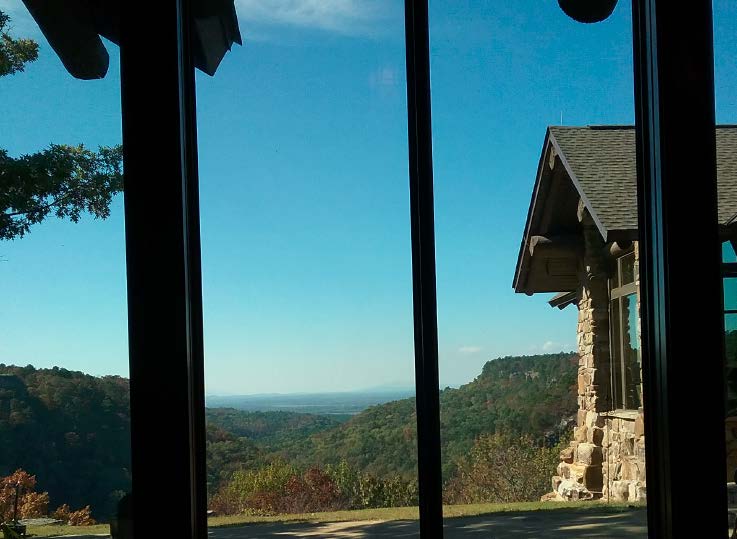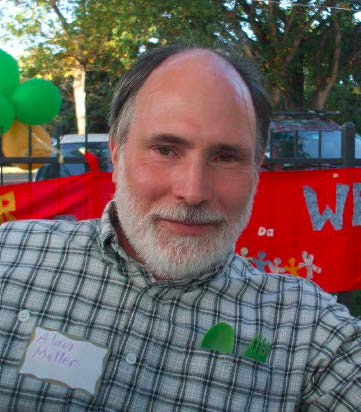Tuesday night in Onalaska
December 17th, 2015
Tuesday night, the Onalaska Plan Commission took up the revised Comprehensive Plan.
Here’s where you can check out the new Comprehensive Plan (search for “transmission” and you’ll find not much):
The current Zoning map (click for larger version):
Do you see any transmission lines on that map? Any pipelines on that map? The City doesn’t have a map of transmission lines, or pipelines, yet it’s a prominent feature of Onalaska, just drive up Hwy 35 or Hwy 53 and you’ll see what I mean. The City Land Use & Development Director said in the meeting that they don’t have one, it would be very difficult to put together and that this info can be regarded as “proprietary.” Not quite, it could be “CEII” information, but when you see it driving down the road, when you look at google and there it is, there’s no reason the City can’t draw a line on the map!
There’s a lot of transmission through Onalaska, lining both sides of the highways, in the middle of the city bottlenecked in-between the river and the bluffs (like Red Wing), and it runs right through the heart of the city. Here’s ATC’s “map” of transmission:
Here’s WI-PSC’s map:
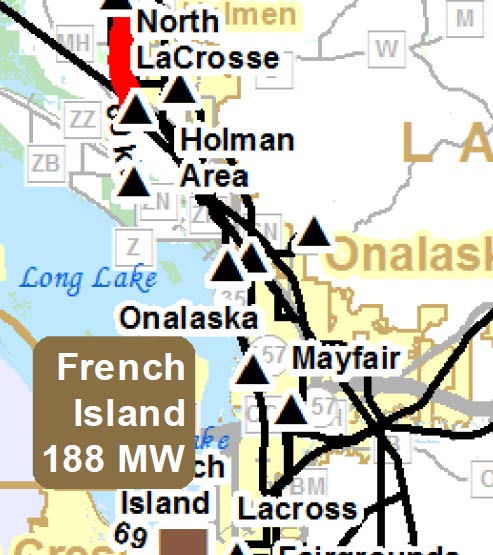 As you can see, it’s not rocket science to put a map together of transmission through Onalaska and its potential expansion areas.
As you can see, it’s not rocket science to put a map together of transmission through Onalaska and its potential expansion areas.
Dairyland is wanting to tear down its old line on the west side of Highways 53 and 35 and virtually double the height of the towers and the capacity. That’s not updating or maintenance, that’s “tear down the old line and build a new one” construction.
NOW is the time, because there’s not yet a Dairyland application, and because Xcel’s line on the east side of Highways 35 and 53 is also old, they’re going to want to “upgrade” soon too. The routing of transmission through Onalaska in light of Wisconsin’s adoption of its Electrical Code which prohibits construction under a line, means that new construction should be carefully reviewed. And right now, rebuilding, tearing down and new construction of something much bigger, shouldn’t be allowed over and next to homes and businesses. What to do? It’s a narrow area with a lot of transmission! But this is what “planning” is all about. Looking into the future and figuring out what they want the City to look like, how they can address the extreme impacts of transmission, and if they can minimize or mitigate these impacts. Here’s an example of it running through people’s back yards, stars indicate pole placement in people’s back yards, and the white/red lines are access roads through people’s back yards!
On behalf of No CapX 2020, I sent the Planning Commission and City Council these comments:
At Tuesday’s meeting, there were few commenters, and they quickly wrestled with the issues raised, and sent it back to the Committee for consideration of transmission issues and impacts.
THANK YOU, ONALASKA PLAN COMMISSION!
Hell Creek State Park (Montana) – Comments due 11/25
November 16th, 2015
 Hell Creek State Park, Montana, circa 1966
Hell Creek State Park, Montana, circa 1966
Comments on the Hell Creek State Park Master Site & Management Plan – Draft_10-28-15 are due November 25, 2015. They’re looking at choices to address the serious overcapacity use of the park, and to determine what to do when the “no-cost lease agreement” with the Army Corps of Engineers expires in 2021. At this point, they’re wanting to address site infrastructure needs, make priority improvements and continue management of site and concession facility under a new contract with USACE. Send Comments, labeled as “Hell Creek State Park – Comments” to:
Montana State Parks1420 East 6th AvePO Box 200701Helena, MT 59620-0701
or online: http://stateparks.mt.gov/news/publicNotices/board/pn_0012.html  Decades ago on a family camping trip, we went to Hell Creek State Park, and it was stunning in its vast austerity. It was on the bank of the Fort Peck Reservoir, the dam being part of our infrastructure tour that summer, and it was so bleak, hot, and dry, I wondered how people survived out there. Here’s the one campsite now with a tree!
Decades ago on a family camping trip, we went to Hell Creek State Park, and it was stunning in its vast austerity. It was on the bank of the Fort Peck Reservoir, the dam being part of our infrastructure tour that summer, and it was so bleak, hot, and dry, I wondered how people survived out there. Here’s the one campsite now with a tree!  We had to drive this intensely bumpy dirt road from Jordan, the nearest town, about 26 miles away, and it took a LONG time. When we got there, we were the only campers, and were warmly greeted by the ranger, who showed us around, warned us about the cactus and said to be careful what shoes we wore because those spines could come right up through flimsy tennis shoes! He also displayed his day’s work, he’d been out shooting rattlesnakes that day, and had half a flour sack full of dead rattlesnakes. I don’t remember a beach, though there must have been a designated swimming area, and for sure there would have been a boat launch. What I do remember of the reservoir, other than the dam, was an old wagon, the wooden kind, with a bench seat, the bench sticking up out of the water, which reminded me of what was probably lurking underneath the water, whatever was left when they flooded the river valley. I’ve wanted to go back there, and now with the camper, it’s on the agenda (let’s hear it for online reservations with photos!). And in looking at the park, I found this Plan, and it presents some interesting issues, ranging from dealing with outfitters who direct clients to the park and use it as a base; moving to increased online reservations and a reservation only system; dealing with water and sewage issues, fish cleaning waste; and campground improvements to water, sanitary sewer system, electrical and cell service (there is NO cell service in the area). If you’re a camper, fisher, hunter, check out this plan and let them know what you think!
We had to drive this intensely bumpy dirt road from Jordan, the nearest town, about 26 miles away, and it took a LONG time. When we got there, we were the only campers, and were warmly greeted by the ranger, who showed us around, warned us about the cactus and said to be careful what shoes we wore because those spines could come right up through flimsy tennis shoes! He also displayed his day’s work, he’d been out shooting rattlesnakes that day, and had half a flour sack full of dead rattlesnakes. I don’t remember a beach, though there must have been a designated swimming area, and for sure there would have been a boat launch. What I do remember of the reservoir, other than the dam, was an old wagon, the wooden kind, with a bench seat, the bench sticking up out of the water, which reminded me of what was probably lurking underneath the water, whatever was left when they flooded the river valley. I’ve wanted to go back there, and now with the camper, it’s on the agenda (let’s hear it for online reservations with photos!). And in looking at the park, I found this Plan, and it presents some interesting issues, ranging from dealing with outfitters who direct clients to the park and use it as a base; moving to increased online reservations and a reservation only system; dealing with water and sewage issues, fish cleaning waste; and campground improvements to water, sanitary sewer system, electrical and cell service (there is NO cell service in the area). If you’re a camper, fisher, hunter, check out this plan and let them know what you think!
Rice in Arkansas
October 29th, 2015
Driving south through Missouri, it was pouring rain, and then into Arkansas, it kept up, and all along Hwy. 67, the fields were flooded, water in the ditches too. But I noticed that there was irrigation, but just a pipe into a field, and there were berms around a field. Much harvesting was done, but there were also fields full of green, and given the temps here, that makes sense. But what were these things that looked like a lot of little corn plants, maybe a foot tall with pretty thick leaves? DOH! They grow rice here!
What’s the scoop? Kind of surprising! 48% of US grown rice is grown in Arkansas! Or 45% depending who you ask. I’d remembered that lots of it was grown here from delivering big bags of rice for D.A.N.C.e Warehouse, but about 1/2 of U.S. rice is pretty amazing for such a small geographic area.
Here’s the How-To for Rice:
Rice Crop Timeline for the Southern States of Arkansas, Louisiana and Mississippi
Heading to Mt. Nebo State Park today, it is beautiful. Here’s today’s view from the office, sunny warm day, don’t miss the Minnesota snow one bit!
West Avenue Redux
September 24th, 2015
The 20 mph flashing sign hasn’t been very effective, so we’ve had this serious traffic calming regimen coming up the hill, and yes, people ARE slowing down! Well, it’s either that or break an axle. So they do, and wind around doing the serpentine, one yahoo ran over a barrel and left a big chunk of bumper in the street, DOH! How do you not see an orange barrel with reflective stripes?!?!
Today they’re filling them in, blocking off one lane of road, ratcheting it up to a “traffic stopping regimen” which is great. But when College Ave. is closed for utility tree cutting, and the intersection of Putnam and Pine is tore up to fix the huge cavern under the side walk and equipment lined up along Pine, it’s kinda hard to get from here to there today!
Will the fix the bank over the Great West Wall?
Muller: Time to think about…
August 23rd, 2015
Commentary by Alan Muller, Green Delaware, in today’s Delaware State News:
Commentary: Time to think about Delaware’s Peterson, Coastal Zone Act
So what about this Coastal Zone Act? What makes it special and worth preserving.
Alan Muller is Executive Director of Green Delaware.
![20151215_185850[1]](https://legalectric.org/f/2015/12/20151215_1858501-1024x576.jpg)
